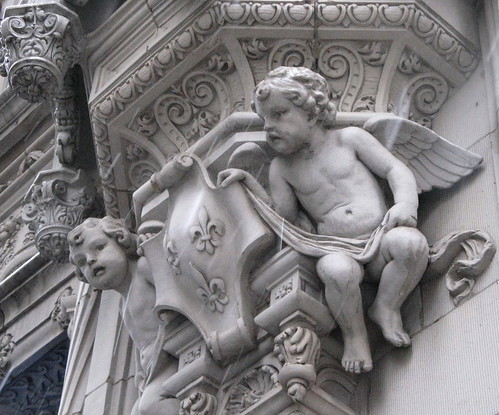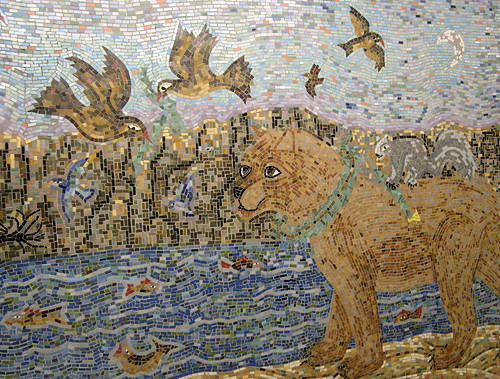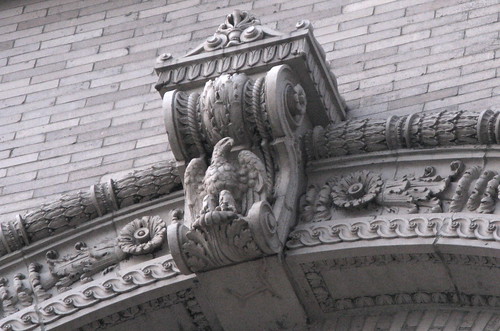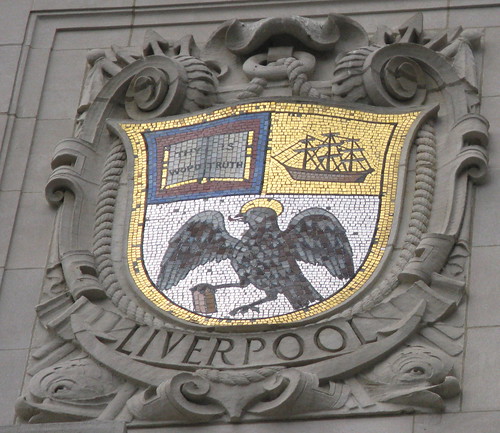In the middle of a number of us playing soccer on a delightful summer evening, one of my partner’s grandchildren said, “Look at that sky!” The sky just before sunset was full of large pink, gray, white, and lavender swirling patterns above. How wonderful that she was aware of the beauty around us and shared what she saw. It was riveting. Though we returned to our soccer within moments, we had taken notice.
As it is with the sky, leaves, rocks, flower petals, waves, and other beauties of nature, so it is with the details and features of buildings, public spaces, and landscapes. The architects who have conceived of picturesque features and dynamic structures, the builders who have carried out their visions, the craftspeople and laborers who have painstakingly put in the tiles of a mosaic or carved wood or stone into distinctive, awe-inspiring shapes and figures, the muralists who have envisioned and painted explosions of color on blank spaces…all have worked to create something for our eyes. Their creations simply await our looking and our awareness.
If we open our eyes as we walk around a street in the city or a town, or down a country lane, and look at the buildings and landscapes, we not only will enjoy what our eyes encounter but we will change ourselves and our lives. I liken looking at architectural and design features to what Thich Nhat Hanh has said about eating a tangerine. In his seminal book, Peace Is Every Step, Nhat Hanh wrote, “If I offer you a freshly picked tangerine to enjoy, I think the degree to which you enjoy it will depend on your mindfulness.” In his tangerine meditation, he invited a group of children to each choose a tangerine, to think of its origins from its “mother tree,” and to peel it slowly, smelling its fragrance and noticing its mist. The children then each slowly ate a bite of the tangerine, savoring its texture and juice.
Taking in architectural or building features is like eating a single piece of fruit. We can enjoy the sight, texture, and wonder of each element. I have always loved looking at buildings and landscapes but for a long time I wasn’t sure why. Then it became apparent over time that the details (among other qualities) – a mosaic, a terra cotta figure, a soaring spire, a sleek curve, a mix of stone – have provided such pleasure. When I gaze at the cherubs on the exterior of the Alwyn Court building, I marvel at their expressions and their fingers, toes, and bellies rendered in terra cotta as soft as flesh. Similarly, I feel a world of creatures come alive in the mosaic “When the Animals Speak” on the 34th Street/Penn Station subway platform.
The angelic figures look down from above at Alwyn Court
A segment of Elizabeth Grajales’ “When the Animals Speak”
Inviting Aimlessness
We often live in our heads more than in our surroundings. We walk with the purpose to get someplace, and our minds are filled with the next deadline, what we will do at our next meeting, what our conversation was with our spouse last night, what our plans will be for the evening or weekend. As I walk in New York and elsewhere, I have found that if I can introduce the slightest bit of aimlessness, slow down for at least a few steps, and breathe deeply, I see many exquisite details and shapes in the buildings and spaces. It is grounding and relaxing, and it creates many happy and serene moments. Something in looking at the eagle on the former subway powerhouse on 11th Avenue, for instance, brings an instant and yet deep sense of power and beauty. Or, a mural that someone has painted on a door of P.S. 152, the School of Science and Technology in Brooklyn, creates a light, joyful feeling.
A watchful eagle on the former New York subway powerhouse
A mural of vibrant colors on a door at P.S. 152 in Brooklyn
This experience is available to us at any time, even with demands and difficulties or when one is filled with anger, sadness, or grief. I remember the day during 1994 that I had to put to sleep my very beloved pet cat, who had been a cherished companion during some difficult times. The sun seemed blinding as I walked with a friend through Central Park. We sat in a gazebo, and I can still see in my mind’s eye the delicate, crafted wooden spindles of that gazebo. It was almost as if someone had created this seat generations ago knowing I would need it and find solace that day. Carefully crafted features speak across the ages and affirm eternity.
When we quiet our minds, details allow us to interact with buildings and landscapes, and we can sense their presence or have a vision from another time period. The building at 1 Broadway (known as the International Mercantile Marine Company Building) in Lower Manhattan prompts such a scene from another era when I look up at its mosaic and terra cotta shields, which have the names of international destinations on them – Liverpool, Gibraltar, Montevideo, Cherbourg, Melbourne, and others. I can sense the travelers who came to this building in the early 20th century to buy their tickets for an ocean voyage. I feel the breezes coming off the New York Harbor and think of its connection to those faraway places. This is how the special touches on a building have a potential to transport us and enliven our imaginations.
A richly adorned shield at 1 Broadway in New York
Car and Consumer Culture
Often, I reflect on how different this is from the buildings we have created in the culture dominated by cars and shopping in recent decades, specifically on suburban roads. Recently, as I traveled by bus on Route 17 in the northern New Jersey suburbs, I noticed that for about 10 miles no features on the buildings, an unrelenting line of shopping centers, big-box stores, and gas stations, drew my interest, curiosity, or attention in the same way. The buildings were very sterile-looking. It is starkly different.
Surrounded by such places, so many of us have lost a reverence for building refinements, art, and even quirkiness due to these settings that are geared not just to speedier travel but primarily to shopping and buying. Not even a window that would entice someone, nor thought to art or pleasure! The contrasts are startling. Yet, thankfully, many people – architects, landscape architects, preservationists, planners, environmentalists, and others – are seeking to encourage the transformation to and support of places attuned to our mindfulness.
Fortunately, we have many beautiful, interesting, and amazing buildings and landscapes still available for our savoring and our constant reawakening. It takes only a few moments in a day to make a difference, and it can be very pleasing, refreshing, and inspiring. We can do it again and again – as long as we choose to look and take notice.
What buildings or landscapes does this bring to mind for you?








This post does a beautiful job of calling out the surprises waiting for us, if we just pause to notice. A Boston tour guide, sharing his passion for the details of Boston’s evolving architecture, gave the suggestion to “Always look up.” This sentence sums up the payoff of pausing and observing: “Carefully crafted features speak across the ages and affirm eternity.” Inspiring post!
Ginny,
Thank you so much! You’re right…”always look up” is one of the best and wisest pieces of advice. I am constantly looking up as I walk in New York and elsewhere — while keeping an eye out for the traffic and pedestrians, of course. The designers and builders of these places surely meant for us to do that.
I am happy that the line about speaking across ages resonated for you. So often, I think of those who are gone but whose work and care live on.
I’m sure that as astute and alive as you are, you must be constantly rewarded for your looking and noticing!
Enjoy!
Susan
Here’s a different thought: bumped into a young man who was heading up a piece of major construction and renovation in Catskill, a building on the main drag, huge space and that connecting to a larger building, in back, being connected with an enclosed pedestrian walkway, going into mixed housing, with very green technology… where’d this kid learn all this? Working at building McDonald’s!
Italian tile men, craftsmen doing the wood work, the landscaping… so, here in Kingston, I am watching teams of men that have taken down a McDonald’s to replace it with another, more modern, more efficient. Looks like a Richard Scarry book, with all the people around there, all at once, doing brick and mortar and power, and cement and lands, and stone work, earth moving, pipe laying and that’s just going on on the outside… quality work, very nicely organized. Yeah, it’s a McDonald’s… but gee, the work is good. It is a responsible corporation, within the limits of its product line, which keeps shifting towards healthier foods..
Gerald,
As always you draw such a picture…I’ve got to see this McDonald’s going up that is smarter and greener. I guess one can compare the health cost of a bacon cheeseburger to the body with the toll that an energy-consuming building takes on the earth. So here’s a healthier menu, healthier buildings…both of those signal a mindfulness.
McDonald’s first opened a prototype green restaurant in Chicago, in 2008, according to The Sunday Times in London.
I can literally see the scene you draw here. We can find our inspiration in some unusual places when we keep looking around.
Thanks so much for sharing this one.
Susan
Hey Susan, great post. It’s interesting how fast the world has gotten and yet how slow we’ve become at processing our surroundings and experiences. The other day I saw an emerald green spider. I mean, it shimmered, it looked like powdered jewels turned into paint that coated this little arachnid. I have never seen that type of spider before and to this day I have not seen another.
I stopped and snapped a picture on my cell phone. My friend was sort of surprised by that. I’m not saying I notice everything; heck, I’m sure I miss most things as I’m always sort of stuck in my head thinking about my book, lol. It doesn’t change the fact that this particular memory stands out more vividly than many other memories. Experiences are so vital, not just to our survival, but to our ability to thrive as people. I would imagine someone with a wealth of vivid memories of life would have less greed in their heart. Just a thought, a theory.
Great post
Kephra
Great post, Susan. And I love the photos – how is it I’ve never seen When the Animals Speak? I will have to look for it. The advice in the comments, “Always look up” is good for all kinds of reasons. Sometimes if you look up, you may see a live raptor – redtail, peregrine, or kestrel perched next to one of those stone or painted eagles! I see them on the water towers and ledges of New York with some frequency. What a gift. Thanks for the reminders.